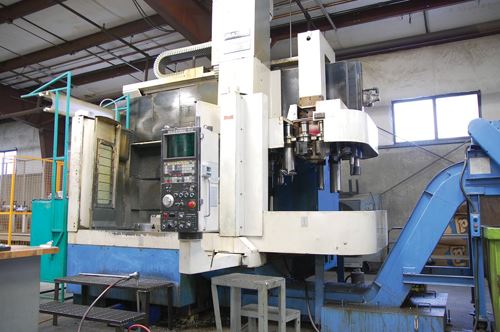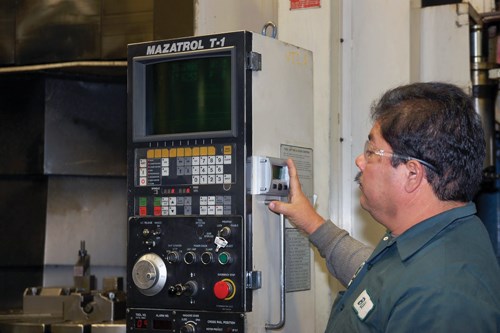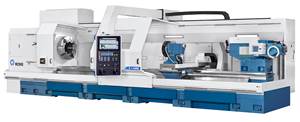Device Rejuvenates Legacy Control System
An old but still very usable vertical turning center became easier to operate, and actually realized more cutting time, thanks to a control retrofit that cost only hundreds of dollars.
One thing that used to keep Ferrell Ramey up at night was a decades-old cassette recorder. The recorder provided the only way to store and load programs on the control of a vertical turning center (VTC) that would cost more than $700,000 to replace. The machine itself could likely provide steady production for many years to come, but only with a more reliable control unit—losing the recorder could mean losing all production on the VTC.
After two lucky years during which the recorder didn’t fail, Mr. Ramey discovered a possible solution in a new device from Calmotion (Chatsworth, California) that enables any machine control with a serial port (and some without) to communicate through an Ethernet network. The LANCNC proved to be the solution that maintained the VTC’s status as a viable production resource.
Mr. Ramey is the information technology manager at Western Valve, a Bakersfield, California-based manufacturer of Dan-Ex double block and bleed valves as well as valves for the defense, refinery and commercial aviation industries. The VTC is a Megaturn A12 from Mazak (Florence, Kentucky) driven by a T1 control with cassette magnetic tape (CMT) protocol. In fact, the problem the shop had with this legacy control is not uncommon among manufacturers with large machining and turning centers. Typically, as in Western Valve’s case, the machine itself can last for years. However, when the manufacturer stops supporting the control, it doesn’t take long for spare parts to run out. Programming capability is lost, and an otherwise productive machine tool becomes useless.
That was precisely the threat faced by Western Valve when it couldn’t locate a replacement data cassette recorder. As an alternative, the company purchased a PC-based software program that was supposed to be able to communicate with the T1 control. Unfortunately, that didn’t turn out to be the case. "We spent nearly $5,000 and more than six months with multiple software patches trying to make it work, but it could not communicate with the T1’s CMT protocol," Mr. Ramey says. "We were left hanging."
The choices soon narrowed to replacing the control and servo systems at an estimated cost of $50,000 or purchasing a brand new VTC for about $750,000. In addition to the high cost, either option would require manually recreating all programs on more than 60 data cassette tapes because the T1 control did not provide an option for switching from Mazak’s proprietary code to G code. With 16 programs on each cassette, that would mean rewriting and proving 960 programs—a daunting task at best.
Perhaps unsurprisingly, Mr. Ramey was quick to purchase the LANCNC for $600 as soon as he heard about it. Initially, the device couldn’t communicate with the machine control when it was connected through the CMT port, so Calmotion provided a software patch to fix the problem. "It worked, and it’s still working," Mr. Ramey says. "Now, the programmer sends the program to the LANCNC in seconds. The operator uses a cursor to highlight the program to be run and clicks ‘send.’ A few seconds later, the program has been uploaded to the control."
The LANCNC acts as an FTP file storage server that operators can access at the control panel of a machine tool CNC. The device operates with standard PC software such as
Microsoft Internet Explorer, and no additional licenses or interface software are required. Programmers can drag and drop files from a PC on a network to the data server where they can be transferred to machine memory, or in the case of large files, drip-fed. Conversely, files in the CNC memory can be sent to the data server and accessed by any PC on the network. In the event of a network crash, the CNC can still access data because the LANCNC stores all files locally on an SD memory card, which comes standard with 2 GB of memory (additional capacity is optional).
The controller not only enabled the machine to continue churning out valve parts, but also improved efficiency. Previously, the T1 had to load all the 16 programs stored on a given cassette tape before running. Even if the intention was to run only a single program, all of them had to be uploaded. Loading data from a new cassette into the control took 15 minutes of valuable production time. In contrast, the LANCNC’s ability to store incremental data files eliminates the need to load all 16 programs on a cassette. The shop also doesn’t have to worry about keeping track of cassette tapes or keeping them free of debris and coolant to avoid damage, either to the cassettes themselves or the data cassette reader. "We gain 15 minutes of production every time we have to load a program, and we no longer worry about tapes breaking or disappearing," Mr. Ramey says.
Western Valve has found other LANCNC functions useful as well. For instance, a search and mid-tape start function enables the program to start at a specific location. If a tool breaks, the operator can restart the program at the exact location where the break occurred rather than running it from the beginning. Preparatory data can be entered prior to executing a mid-tape start. The device has also helped the company pass ISO audits because the old method of backing up programs likely would not have satisfied the audit requirements, Mr. Ramey says.
In fact, the device worked so well that the shop decided to purchase additional LANCNCs for use on two of its other Mazak turning centers. "After we moved the programs from the cassettes to a hard drive on our PC, we no longer worried about missing cassettes or the data cassette reader failing," he concludes. "We’re no longer stuck in a technological time warp."
Related Content
Inverting Turning and Five-Axis Milling at Famar
Automation is only the tip of the iceberg for Famar, which also provides multitasking options for its vertical lathes and horizontal five-axis machine tools.
Read MoreRomi Launches Flatbed Lathe for Machining Large Parts
The C 1100H is a heavy-duty flatbed lathe built with a monoblock cast iron bed that absorbs machining efforts and vibration, making it highly rigid, stable and accurate.
Read MoreModern Bar Feeds Bring New Life to Automatic Swiss Lathes
Cam-actuated Swiss lathes are still the fastest way to process many parts. By adding modern bar feeders, this shop has dramatically improved their utilization with the ability to work unattended, even in a lights-out environment.
Read MoreDeep Hole Drilling Without Drift
A deep hole drill with intuitive controls and minimal hole drift was one shop's pipe dream — until the shop helped a machine tool builder make it.
Read MoreRead Next
3 Mistakes That Cause CNC Programs to Fail
Despite enhancements to manufacturing technology, there are still issues today that can cause programs to fail. These failures can cause lost time, scrapped parts, damaged machines and even injured operators.
Read MoreThe Cut Scene: The Finer Details of Large-Format Machining
Small details and features can have an outsized impact on large parts, such as Barbco’s collapsible utility drill head.
Read More














.png;maxWidth=300;quality=90)












